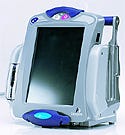Infusion System Promotes Safe Dispensing of Medication
May 25, 2007
Originally Published MPMN May 2007
ENGINEERING EXCELLENCE
Infusion System Promotes Safe Dispensing of Medication
|
The Symbiq infusion system dispenses medication precisely at a low level, a must for safe infant care. |
There is always the chance of a mistake being made when medicines are dispensed through hospital infusion systems. Human error can result in the wrong medication or dosage being dispensed, or the pump mechanism can malfunction, causing a patient to receive too small or too large a dosage. To address the need for greater patient safety, Hospira Inc. (Lake Forest, IL; www.hospira.com) began planning and developing a device in 2003. Now completed, the Symbiq infusion system—the result of collaboration between Hospira, Minnetronix Inc. (St. Paul, MN; www.minnetronix.com), Design Concepts Inc. (Madison, WI; www.design-concepts.com), and others—has won a 2007 Medical Design Excellence Award (MDEA). The device is an electronics-based medication management infusion system that delivers and monitors infused (intravenous) patient medications.
Minnetronix was brought in on the project because of its expertise in systems design engineering and integration, says Rich Nazarian, company president. Founded in 1996, Minnetronix specializes in complete product development—design, engineering, and manufacturing—and exclusively works on medical products. Previously, the company has developed a cardiac recovery system, the cPax aneurysm treatment system, a neuromuscular electrical stimulator, and a total artificial heart. But it was Minnetronix’s experience with electronics related to infusion pumps that attracted Hospira. Hospira developed a new pump for the Symbiq infusion system specifically for use with electronic components, as none of its existing pumps had enough horsepower for electronic integration.
“We knew a lot going in about infusion pumps as far as the product needs and the possible problems that could occur,” Nazarian says. “Safety is critical, and [the Symbiq infusion system] is a complicated device.” Minnetronix ended up serving as an electrical design consultant on the project, and wrote some of the embedded code. Fluid control is vital, and the Symbiq infusion system avoids free flow, boasting a ±5% rate of accuracy across the entire delivery range, enabling hospitals to meet the needs of all care areas. The ability to dispense precisely at a low level is particularly important in providing safe care to infants.
Electronic control of the pumping system enables most of the Symbiq infusion system’s key safety features. The device software is not a stand-alone platform, but allows for the complete integration of medical management software when the device is connected to a network. The nurse or caregiver can look up patient information, medication information, and dosage guidelines on the device’s touch screen monitor, helping to reduce the chance of human error. The integrated drug library design allows hospitals to ensure compliance with their best practices in all medication programming sequences, and an event log feature allows practitioners to track medication risk events. Despite the abundance of features, simple programming was emphasized in the development phase to make the device easier for clinicians to learn to use.
Design Concepts—a product development and design company that serves several industries—was brought on the project to simplify the user experience further. The company designed the large, backlit LCD touch screen, which features large buttons, as well as graphics and text that can be viewed easily by a clinician with 20/40 vision.
Dave Franchino, president of Design Concepts, says that although the Symbiq infusion system is a “very clever device,” he emphasizes that it was not created in a vacuum. “Hospira located an area of care where they thought they could make an impact and difference,” Franchino says. “And they were collaborative and team oriented from the beginning with the companies and suppliers that contributed to the project.”
Copyright ©2007 Medical Product Manufacturing News
You May Also Like



